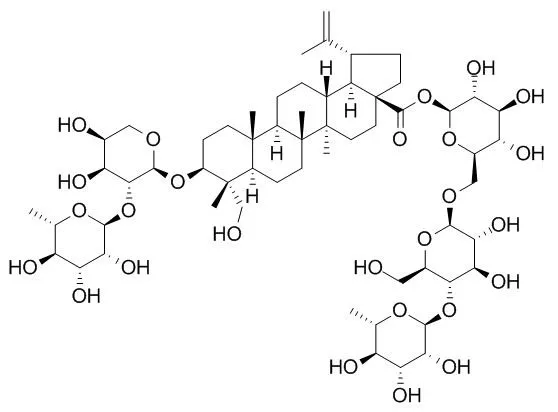| Description: |
1. Anemoside B4(AB4) and tetrandrine(Tet) have some reversal effect on resistant to L-OHP in Lo Vo/L-OHP cells, the molecular mechanism of the resistance reverse effect was related to down-regulation of P-gp for AB4 and down-regulation of z DHHC9 for Tet.
2. Anemoside B4 can inhibit the production of IL-6,secretion of IL-8, downregulate E-selectin expression, and decrease the content of TXB(2), it reduces inflammatory response, thus relieving intestinal dysfunction via multiple pathways.
3. Anemoside B4 may potentially have a capacity to regulate immune responses in vivo via changes in production of these select cytokines by infected endothelial cells.
|
| In vitro: |
| Immunopharmacol Immunotoxicol. 2009;31(4):550-5. | | Chinese herbal medicinal ingredients inhibit secretion of IL-6, IL-8, E-selectin and TXB2 in LPS-induced rat intestinal microvascular endothelial cells.[Pubmed: 19874221 ] |
METHODS AND RESULTS:
The aim of the research was to investigate the anti-inflammatory mechanism of Pulsatillae Decoction (PD), the levels of interleukin (IL)-6, IL-8, E-selectin, and thromboxane B(2) (TXB(2)) secreted by cultured rat intestinal microvascular endothelial cells (RIMECs) were determined after treatment with its active ingredients, namely Anemoside B4, anemonin, berberine, jatrorrhizine, palmatine, aesculin, and esculetin. RIMECs were challenged with 1 microg/mL lipopolysaccharide (LPS) for 3 h, and then treated with each of the seven ingredients at three concentrations (1, 5 and 10 microg/mL) for 24 h. The results revealed that anemonin, aesculin and esculetin inhibited the production of IL-6, aesculin and esculetin inhibited the secretion of IL-8, Anemoside B4, berberine and jatrorrhizine downregulated E-selectin expression, anemonin, berberine, jatrorrhizine and palmatine decreased the content of TXB(2). All these changes were significant.
CONCLUSIONS:
Taken together, the data suggest that all seven active ingredients of PD can effectively reduce inflammatory response, thus relieving intestinal dysfunction via multiple pathways. | | Pharm Biol. 2015 Jan;53(1):1-9. | | Cytotoxicity of the compounds isolated from Pulsatilla chinensis saponins and apoptosis induced by 23-hydroxybetulinic acid.[Pubmed: 25026337] | The rizoma of Pulsatilla chinensis (Bunge) Regel has been used as a traditional Chinese medicinal herb for thousands of years. Total saponins from P. chinensis can induce the apoptosis of solid cancer cells; however, their activity on chronic myeloid leukemia and the mechanisms remains unknown.
To study the activity of total saponins and the main active fractions from P. chinensis saponins on chronic myeloid leukemia, and to illustrate the mechanisms underlying the anticancer activities.
METHODS AND RESULTS:
The cytotoxic activity were assayed by MTT; cell cycle arrest and apoptosis were tested by flow cytometry system; changes in the mitochondrial membrane potential were determined using JC-1; and the apoptosis signaling pathway was determined by western blotting.
We demonstrated that total P. chinensis saponin displayed cytotoxic activity against K562 cell line. In addition, we identified 23-hydroxybetulinic acid (HBA), pulchinenoside A (PA), and Anemoside B4 (AB4) from the total saponins, with the most cytotoxic compound HBA. Glycosylation at C3 and C28 of HBA significantly reduces its cytotoxicity. HBA could promote cell cycle arrest at S phase and induce apoptosis via intrinsic pathway. HBA disrupts mitochondrial membrane potential significantly (p < 0.01) and selectively downregulates the levels of Bcl-2, survivin and upregulates Bax, cytochrome C, cleaved caspase-9 and -3.
CONCLUSIONS:
Total saponins from P. chinensis may be effective natural products against human chronic myelogenous leukemia; HBA is one of the bioactive components responsible for its anticancer activity, and could be further investigated as an alternative therapeutic drug for leukemia. |
|






 Cell. 2018 Jan 11;172(1-2):249-261.e12. doi: 10.1016/j.cell.2017.12.019.IF=36.216(2019)
Cell. 2018 Jan 11;172(1-2):249-261.e12. doi: 10.1016/j.cell.2017.12.019.IF=36.216(2019) Cell Metab. 2020 Mar 3;31(3):534-548.e5. doi: 10.1016/j.cmet.2020.01.002.IF=22.415(2019)
Cell Metab. 2020 Mar 3;31(3):534-548.e5. doi: 10.1016/j.cmet.2020.01.002.IF=22.415(2019) Mol Cell. 2017 Nov 16;68(4):673-685.e6. doi: 10.1016/j.molcel.2017.10.022.IF=14.548(2019)
Mol Cell. 2017 Nov 16;68(4):673-685.e6. doi: 10.1016/j.molcel.2017.10.022.IF=14.548(2019)